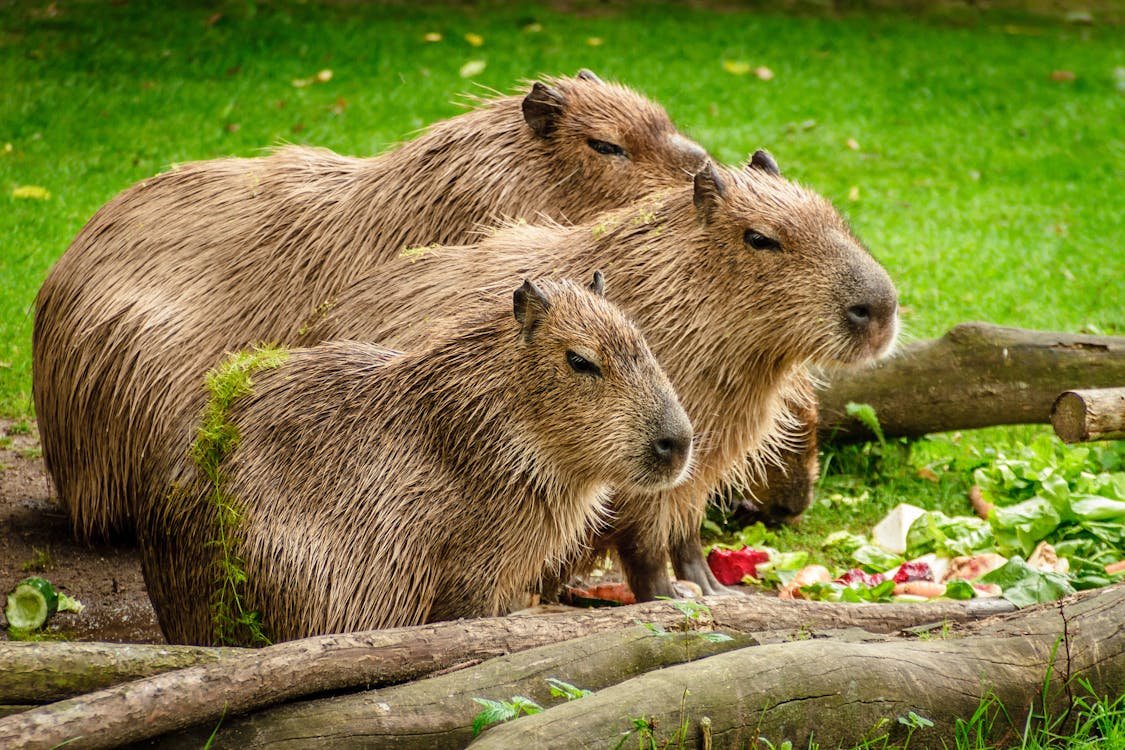Understanding Capybaras
Capybaras (Hydrochoerus hydrochaeris) are the largest rodents in the world, native to South America, particularly found in countries like Brazil, Venezuela, Colombia, and Argentina. They thrive in diverse habitats, including rainforests, savannas, and near bodies of water such as rivers, lakes, and wetlands. Their semi-aquatic nature allows them to adapt seamlessly to their environment, utilizing water for both comfort and protection from predators. Capybaras are social creatures, often living in groups that may contain anywhere from 10 to 20 individuals, although larger congregations can form during the dry season when resources are limited.
Physically, capybaras feature a robust body with a barrel shape, short legs, and a slightly elongated head. They can weigh between 77 to 146 pounds and measure about 3.5 feet in length. Their fur is coarse and usually brown in color, providing excellent camouflage in their natural surroundings. This unique coloration, combined with their semi-aquatic lifestyle, helps capybaras evade various predators, such as jaguars and caimans.
Social behavior is a vital aspect of capybara life. These rodents display strong social bonds, often grooming and vocalizing to communicate with one another. Their hierarchical structure ensures stability within groups, as dominant males and females are typically involved in maintaining order. Unlike many other rodent species, which can be solitary or territorial, capybaras exemplify a communal lifestyle that enhances their chances of survival through cooperative living and mutual support.
In comparison to other rodents, such as mice or squirrels, capybaras distinguish themselves with their size and social nature. While many rodents lead solitary lives, capybaras thrive in community settings, creating complex relationships within their groups. Understanding these characteristics highlights the vital role capybaras play in their ecosystems, promoting biodiversity and stability in their native habitats.
Lifecycle of Baby Capybaras
The lifecycle of baby capybaras, known for their playful and social nature, begins with a gestation period of approximately 150 days. This period occurs after mating, during which the female capybara becomes increasingly selective about her habitat, seeking safe locations that offer shelter and access to water. Capybaras typically give birth to a litter ranging from one to eight babies, known as pups. Upon birth, these pups are remarkably precocial, meaning they are relatively mature and mobile. They possess a full coat of fur and can even walk shortly after emerging into the world.
In their early days, baby capybaras are heavily reliant on their mothers for nourishment and protection. The mother capybara nurses her offspring, providing essential nutrients vital for their growth and development. Nursing may continue for up to sixteen weeks, during which the pups not only develop physically but also learn crucial survival skills. The mother’s role extends beyond breastfeeding; she also teaches her young about their environment, including where to find food, water, and shelter from predators.
Family units within capybara communities are tightly knit, offering additional support in rearing the pups. The family structure helps babysit and protect the young during vulnerable moments. After a few weeks, the weaning process begins, and the pups start to graze alongside their mothers while consuming grass and aquatic plants. This transition marks an essential phase in their development as they adapt to a more independent diet.
Throughout their infancy, baby capybaras are characterized by their curiosity and playful demeanor. They engage in social play, which is crucial for developing social bonds and establishing hierarchy within the group. As they learn to navigate their surroundings, these interactions enhance their adaptability and overall well-being. This joyful period in their lifecycle underscores the importance of both maternal guidance and social engagement among their peers.
Behavior and Social Interactions
Baby capybaras, known for their playful nature, exhibit a range of behaviors that are crucial for their development. These young rodents engage in frequent playful interactions with their siblings, fostering social bonds that are integral to their growth. Play is a significant aspect of their daily lives and serves multiple purposes, including the honing of physical skills and the establishment of social hierarchies within their groups.
The communication methods employed by baby capybaras are diverse and sophisticated. These cute creatures use various vocalizations, such as whistles and barks, to express their emotions and coordinate activities within their community. Body language also plays a vital role in their interactions—subtle movements, including grooming or aligning their bodies closely, help convey trust and affection. Understanding these communication cues is essential for recognizing the dynamics of capybara communities.
Social structure is another vital component of their behavior. Capybaras naturally form groups, typically composed of multiple adult females, their offspring, and a few males. Within these groups, social hierarchies are evident, influencing interactions among members. Baby capybaras learn to navigate these hierarchies through observation and participation in play, which prepares them for adult roles. Conflicts, while minimal, may arise, and the resolution of such disputes is often managed through vocal exchanges and ritualistic displays, thus reinforcing social bonds and cohesion.
In summary, the behaviors of baby capybaras—characterized by playful interactions, varied communication methods, and the formation of social structures—are essential for their development. Through these activities, they acquire the skills and social knowledge necessary to thrive in their communities as they mature into adults.
Conservation and the Importance of Capybaras
Capybaras, recognized as the world’s largest rodents, play a significant role in maintaining ecological balance in their habitats. Found primarily in South America, these creatures thrive in abundant water sources, such as rivers, lakes, and wetlands. Unfortunately, the conservation status of capybaras is becoming increasingly precarious due to various environmental pressures, including habitat loss and degradation linked to human activities. Urbanization, agricultural expansion, and the draining of wetlands contribute to the diminishing living spaces for these gentle creatures. As a result, their populations face notable threats, which raises an urgent need for conservation efforts.
Moreover, the pet trade presents another layer of concern regarding baby capybaras. While their playful demeanor and adorable appearance make them appealing as pets, the implications of domestication can be detrimental to wild populations. Many prospective owners are unaware of the complex social needs of capybaras, leading to situations where animals are relinquished or abandoned. Therefore, it is essential to approach the pet trade with caution and respect for their natural behaviors and requirements.
Capybaras significantly contribute to biodiversity within their ecosystems. As herbivores, they help maintain plant growth and serve as prey for several predators, thus forming an integral part of the food web. The loss of capybara populations could disrupt this balance, leading to negative repercussions for numerous species sharing their habitat. Preserving their natural environments is critical to ensuring their survival and the health of the ecosystem as a whole.
By raising awareness about the importance of capybaras in maintaining biodiversity and the ethical concerns surrounding their domestication, individuals can take active steps toward conservation. Supporting organizations focused on habitat preservation, responsible pet ownership, and engaging in community awareness programs are practical ways to contribute to the safeguarding of these adorable creatures. Through collective efforts, it is possible to ensure that capybaras continue to thrive in their natural settings for generations to come.





